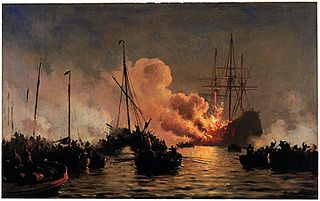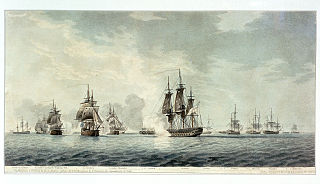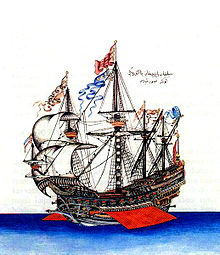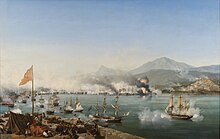
The Battle of Sinop, or the Battle of Sinope, was a naval battle that took place on 30 November 1853 between Imperial Russia and the Ottoman Empire, during the opening phase of the Crimean War (1853–1856). It took place at Sinop, a sea port on the southern shore of the Black Sea. A Russian squadron attacked and decisively defeated an Ottoman squadron anchored in Sinop's harbor. The Russian force consisted of six ships of the line, two frigates and three armed steamers, led by Admiral Pavel Nakhimov; the Ottoman defenders were seven frigates, three corvettes and two armed steamers, commanded by Vice Admiral Osman Pasha.

The Third Battle of the Dardanelles in the Fifth Ottoman-Venetian War took place on 26 and 27 June 1656 inside the Dardanelles Strait. The battle was a clear victory for Venice and the Knights Hospitaller over the Ottoman Empire, although their commander, Lorenzo Marcello, was killed on the first day.

The Battle of Tendra was a naval action fought on 8 and 9 September 1790 in the Black Sea as part of the Russo-Turkish War (1787–1792). It ended in a decisive victory for Ushakov's Russians over the Ottomans.

The naval Battle of (the) Kerch Strait took place on 19 July 1790 near Kerch, Crimea, was a victory for Imperial Russia over the Ottoman Empire during the Russo-Turkish War, 1787-1792.

The Battle of Køge Bay (1710) also referred to as the Second Battle of Køge Bay, was an indecisive battle that took place on 4 October 1710, during the Great Northern War, in Køge Bay, just south of Copenhagen. Denmark had 26 ships of the line and 5 frigates with 1808 guns, and Sweden had 21 ships of the line and several frigates with 1512 guns. The Danish ship Dannebroge exploded and of the 550-man crew only 9 survived. The Swedish ships Tre Kronor and Prinsessan Ulrika Eleonora ran aground. Because of the weather the battle could not continue. However, the Swedish fleet managed to sink and capture a Danish convoy of transport ships that were supposed to embark a Russian invasion force in Danzig. The action in Køge Bugt checked those Russian invasion plans of Sweden.
This is a listing of ships that fought at the Battle of Athos, 30 June 1807, during the Russo-Turkish War of 1806–1812. Spelling of Turkish ships is uncertain.

Courageuse was a 40-gun Virginie-class frigate of the French Navy, completed in 1794 and renamed Justice in April 1795. The British and Ottomans captured her in 1801 at the siege of Alexandria and she became a prize to the Ottomans.

Feyzâ-i Bahrî was one of four wooden-hulled Mecidiye-class paddle frigates built for the Ottoman Navy in the 1840s; they were the first Ottoman-built warships powered by steam. She served with the fleet until 1867, including during the Crimean War, where she saw a minor battle with a Russian frigate in the Black Sea. Feyzâ-i Bahrî ferried soldiers to Crete during the Cretan Revolt in 1866 and was converted into a dedicated transport vessel the following year. She served in that capacity until 1878 when she was decommissioned, being broken up in 1880.
Chesma was an 84-gun ship of the line built for the Black Sea Fleet of the Imperial Russian Navy in the 1840s. Chesma carried a battery primarily consisting of tradition shot-firing guns, but she also carried four new shell-firing guns. The ship saw combat during the Crimean War at the Battle of Sinop against an Ottoman squadron in 1853, where the Russian shell guns proved to be decisive. The battle prompted Britain and France to intervene to support the Ottomans, leading the Russian fleet to withdraw to Sevastopol to avoid a battle with an Anglo-French fleet. Chesma helped to defend Sevastopol, supporting Russian ground forces during a battle in February 1855 before being disarmed to strengthen the city's defenses and then scuttled to block the harbor entrance to the Anglo-French fleet in August.
This page is based on this
Wikipedia article Text is available under the
CC BY-SA 4.0 license; additional terms may apply.
Images, videos and audio are available under their respective licenses.


















